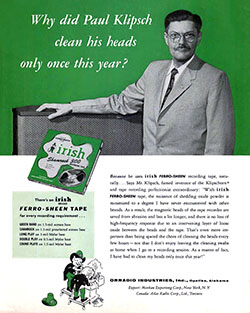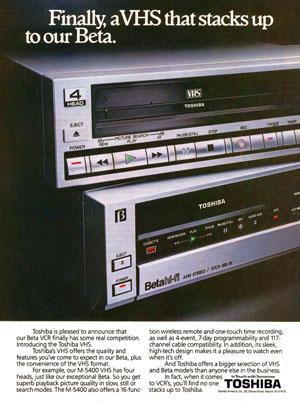Original URL: https://www.theregister.com/2013/10/10/history_of_magnetic_tape_part_three/
Video thrilled the radio star: Tracking the history of magnetic tape
Part three... That's entertainment
Posted in Personal Tech, 10th October 2013 09:03 GMT
Feature El Reg's magnetic tape odyssey has covered tape's early beginnings in sound recording in part one and its revolution in computing in part two. In this final part, we look at how film and TV became some of magnetic tape's best customers.
The music and computer industries weren’t the only early adopters of magnetic tape. The motion picture industry was certainly interested as it began to seek more versatile and higher quality alternatives to the optical soundtrack.
The latter had finally ousted synchronised disc recordings to become a standard in the 1930s, but film-makers kept looking for something a bit less messy.
Variable Density (V/D) and Variable Area (V/A) soundtracks compared
The optical soundtrack – essentially "sound-on-film" – initially appeared as a continuous variable density (V/D) optical track alongside the film frame appearing as lines in various shades of grey, somewhat similar to a barcode.
Even though these soundtracks could produce a fairly respectable frequency response of 31Hz to 12.5kHz, they could be noisy, distorted and multi-channel audio was problematic in those early days. The Variable Area (V/A) soundtrack, with its sinusoidal tracking, had lower distortion but it still had limitations in its early development stages.
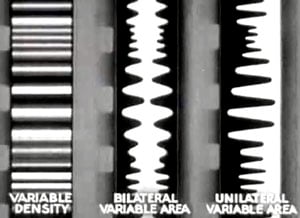
Vintage optical soundtracks: more on YouTube
It was The Robe, presented in Cinemascope, that was the first major feature to use a four-track magnetic soundtrack bonded to both edges of the film. It premièred on 16 September, 1953.
Indeed, the year before, This is Cinerama had wowed audiences with its an extravagant multi-projection presentation featuring 3 x 35mm films running in sync. For audio, it had a fourth 35mm reel which was a seven-track magnetic tape, not film. This was more sensible than trying to get soundtracks from three projectors to work in sync. In theatres, there were five speakers behind the screen with the other two at the back or the sides.
An alternative was to utilise magnetic tape bonded to either side of the film sprockets holes, which could be used for multichannel sound. Early tape production had originally used a film base so it wasn’t a major effort getting this implemented.
Even with the less complicated magnetic strip arrangements around the sprocket holes – delivering six-track playback – the optical soundtrack didn’t disappear. The genius of the late Ray Dolby provided the means for noise reduction on both magnetic and optical soundtracks to be applied.
Ray Dolby describes his experiences of the early film soundtracks and his work on improving them
Furthermore, Dolby Stereo, as it was called, enabled four tracks to be decoded from a stereo pair on optical soundtracks. The Dolby Stereo matrix delivered Left, Right, Centre and Surround. The real kicker was it was backwards-compatible and these tracks could even be played with conventional stereo sound equipment or in older mono theatres from the same film print.
Light fantastic
In fact, Dolby Stereo was so successful in this four-channel guise that it killed off magnetic tape tracks on 35mm film releases. And while we’re on the subject of Dolby Stereo, those film prints that made it to VHS Hi-Fi tape, Laserdisc or stereo television broadcast would end up in the consumer equivalent matrix system, Dolby Surround, which lacked the centre speaker channel but kept the rear surround channel. So one way or another, those optical soundtracks did end up on tape again.
Cinema didn’t abandon magnetic media though, and numerous 70mm film formats came and went supporting analogue multitrack options featuring up to six tracks. Yet it was the digital domain that was to fuel a renaissance in cinema sound, with Dolby Digital pioneering its progress along with DTS (formerly Digital Theatre Systems) and Sony Dynamic Digital Sound (SDDS), all vying for position on a 35mm film print along with the analogue optical soundtrack that refuses to die some 90 years since its first professional outing.
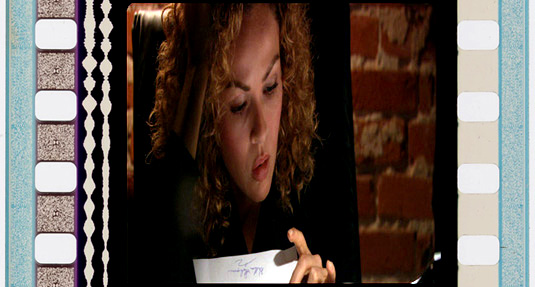
Anamorphic film optical tracks: SDDS (blue edges), Dolby Digital (sprocket holes left), analogue (left of frame)
Source: Wikimedia, from Adakin Productions' Descent.
And if you’re wondering just how these formats could live side-by-side around the sprocket holes of film frame, here’s how they do it.
The now defunct SDDS appears on the main optical strips on both film edges delivering 8-channel sound. DTS is alongside the film frame as an optical track of tiny dashes; it’s actually a timecode that’s used to run the DTS audio on an external processing device equipped with a CD-ROM of the film soundtrack.
The analogue optical soundtrack is in its usual spot between the sprocket holes and film frame. Dolby, as always, is the smartypants here as the Dolby Digital track uses the area between each sprocket hole. Originally called SR•D and a six-track format, the Dolby Digital soundtrack is actually optically recorded.
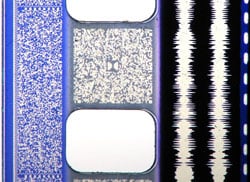
Film frame close-up showing dotted DTS track (right)
Source: Wikimedia, 35mm film soundtracks
Technically, it's quite remarkable and the perceptual coding data reduction algorithms used in the AC-3 audio streams [PDF] would form the foundations of AAC used in iTunes and MPEG video soundtracks. More details on the original Dolby Digital format here [PDF].
Another consequence of this cleverness was Dolby Digital film prints could retain the analogue optical tracks featuring Dolby SR for older theatres or for use as a backup. Cinema surround channels aside, Dolby SR was an advanced 10-band noise-reduction system that was championed on analogue multitrack tape recorders and was claimed to be better than the digital recording systems of the time – technical paper here [PDF].
It would be easy to fill up these pages with Dolby's achievements in cinema, but this diversion is just another example of his ability to maximise the capabilities of recording media, be it magnetic or optical.
As for the SDDS format, it too used a perceptual coding system called ATRAC that was also utilised in Sony's MiniDisc recorder. SDDS was discontinued in 2005, Sony SDDS VP Robert Ott explains the reasons in this farewell letter here [PDF].
Roll VTR
It’s all very well knocking out a soundtrack at 24fps with a photographic image fluttering alongside through a projector, but storing both sound and picture on magnetic tape is a challenge of an entirely different magnitude.
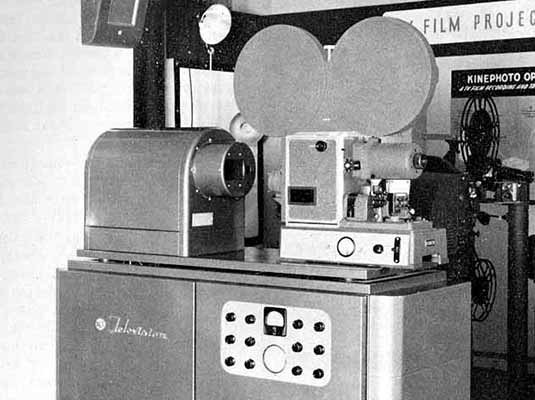
The kinescope would film live television broadcasts before video recorders became available
Video killed the live TV star
Television broadcasting had the same issues Bing Crosby grappled with over his radio shows: performances were live and unlike the pre-tape era audio disc recording option, programmes couldn’t be repeated unless they were recorded with film cameras. This scenario would typically involve the use of a kinescope (telerecorder) which would film the broadcast image of shows from a video monitor screen.
There was no instant playback with a kinescope. So Ampex, which was looking to capitalise on its expertise in audio with video, set about the task with gusto. On this side of the pond, the BBC’s own R&D boffins had the same goal but a very different approach, which we’ll come to in a moment.
RCA was also busily researching video recording but in those early days, all parties concerned with video recording were focused on redesigning methods used for audio based around longitudinal recording – spooling from one reel to another over a stationary recording/playback head.
Given that the video frequencies involved went up to 4MHz for TV back then, even the most finely crafted machines needed to transport the tape at around 200IPS. To get an hour of programming, one reel would be 38 inches in diameter and contain 60,000ft of tape. Think less "finely crafted machine" and more "diesel truck" to spin that payload.
Yet spin it they did. The reels were smaller – at 17 inches – but on 1 December, 1953, RCA demonstrated a video recorder that clocked up speeds of 360IPS, which were difficult to maintain steadily and didn’t deliver on bandwidth either.
The recording time was a mere four minutes and, somewhat bravely, RCA was planning 19-inch reels to notch up 15 minutes on 1/2-inch tape for colour and 1/4-inch tape for monochrome.
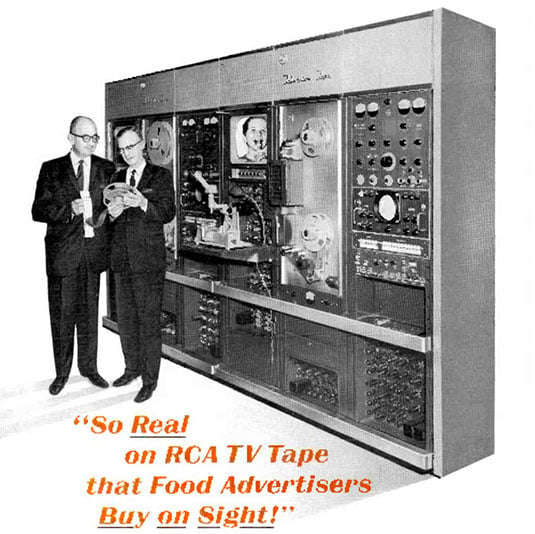
RCA might not have been the first to market with video but it was a pioneer in colour video recording
Colour needed a wider tape, as five tracks were utilised for red, green, blue and sync, plus one for audio. Monochrome telly just needed one track for video and one for audio. RCA persevered for another three years with its longitudinal video recorder (LVR), clocking up a number of innovations along the way, but not the glittering prize of a practical video recorder. Still, RCA was in good company on this point.
Spin theory
The BBC’s Vision Electronic Recording Apparatus (VERA) had 20.5-inch reels spinning 1/2-inch tape at 200IPS and managed 15 minutes of programme time. The idea was to use two machines, so one could be on standby and the other recording. After the swapover, the other would be loaded back up again with more tape.
Dr Peter Axon talks about Auntie's VERA
The project began in 1952, headed up by Dr Peter Axon, and was based around the 405-line monochrome TV standard. It took until 1958 to complete. It used two tracks for video separating high- and low-frequency content and another track for audio, all with various modulation techniques thrown in. Alas, the picture was unstable due to sync information not always being satisfactorily recorded and was soon dubbed “wobbly TV”.
You can see for yourself the quality of the recording, from the Panaroma programme demonstrating the system on 14 April, 1958.
VERA demonstrated live on BBC television in 1958
For Ampex, the production of its own video recorder took four years. It wasn’t viewed as priority and was even shelved a couple of times. After much discussion on technical aspects, work proper began back in December 1951 with only a small budget set aside to see if the initiative to utilise a rotating head array would bear fruit.
The write stuff
The design comprised three heads mounted on a drum writing across from one edge to another on 2-inch tape running at 30IPS. The head-to-tape speed that this spinning drum enabled was in the region of 2,500IPS. With this rate of travel, the bandwidth would be sufficient to support recording frequencies up to 2.5MHz.
It was literally an example of lateral thinking and Ampex wasn’t alone with this idea. RCA had a patent on rotary head recorders yet the company put its top audio technician, Harry Olson, in charge of its video project and he stuck to longitudinal, stationary head recording. The Japanese were also exploring rotary head recordings, more about their contributions later.
In May 1952, the video work at Ampex actually ceased while all hands were busy on a one-off instrumentation recorder. This turn of events, which lasted three months, was quite serendipitous as the young Ray Dolby got to rub shoulders with the video team who’d had to chip in on this project.
Dolby, an engineering student with no formal training had been working part-time at Ampex since he was 17. Now 19, his natural talent and technical nous made an immediate impression on the video recorder development work when it was restarted in August 1952.
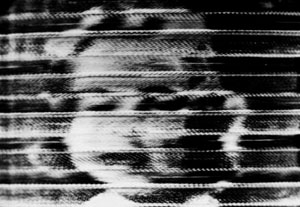
AM picture recording replete with venetian blind effect
In fact Dolby was so keen, he dropped out of college to work full-time on the endeavour and was consequently drafted into military service in March 1953. One of those rare moments when he didn’t think out of the box, as his student draft deferment was no longer valid. It would take until the end of 1954 before Dolby showed up at Ampex again, working part-time and attending college.
He didn’t miss too much though, as instability blighted the development work due to problems in tracking accuracy which would lead to the venetian blind effect – no, not the clichéd transitions found in Adobe Premiere and the like, but stripy lines across the video playback screen indicating timebase errors. Things were so bad, that all concerned agreed to take a break, have a rethink and work on other projects within the company.
Some backroom work did continue that led to some of the earlier problems being resolved. On the strength of this progress, work eventually recommenced following an internal demo on 1 September 1954. Among the changes was a new approach to wrapping the around the drum tape and the use of four heads.
The actual construction of rotary heads was a new task altogether and Ampex used a ferrite core with metal tips. These had to be glued into the drum, but as the green epoxy glue took time to harden, shortcuts were often taken to facilitate tests of recorder circuitry and heads would loosen as a result of the centrifugal forces produced by the high speed spinning.
The Dolby system
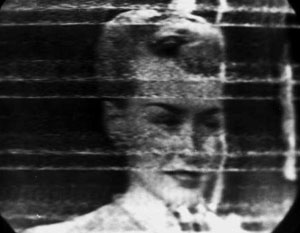
The first FM picture recording shows promise
Among the tests was the idea of replacing the AM signal with FM instead. An idea introduced by Charles Anderson leading to a successful FM image being produced in February 1955. Dolby had a hand in this too, as he worked on making the FM circuit design much simpler which differed to Anderson’s approach.
At the end of the day, Dolby’s use of a multivibrator modulator won out, producing a superior picture than Anderson’s reactance valve methods. Things were looking so good that the Ampex team ran a demo for the top brass at Ampex on 2 March 1955.
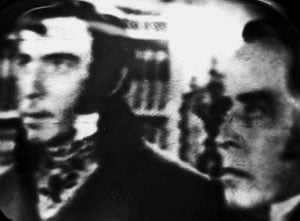
Further improvements in FM for the Ampex execs demo
Further work led to breakthroughs regarding the useful effect of variable tape tension on image consistency between machines, and new head construction techniques – a sandwich design which proved more robust and easier to manufacture. Audio was recorded longitudinally on a conventional stationary head.
Bandwidth and other improvements led to another internal Ampex demo in February 1956 which included recording of the actual audience and playback immediately afterwards. It brought the house down and, buoyed by this reception, the team then focused on a public demo at the National Association of Radio and Television Broadcasters (NARTB) Convention in Chicago 14 April 1956, with some secretive private viewings beforehand to broadcasters.
This led to an invitation to demonstrate the Mark IV recorder at the CBS Affiliate’s Meeting the day before the NARTB show. Yet the feedback from the CBS engineers was that the quality wasn’t up to scratch. Fred Pfost, who had been working tirelessly on the head design, made adjustments right to the last minute and, combined with other tweaks from the team, notched up further enhancements.
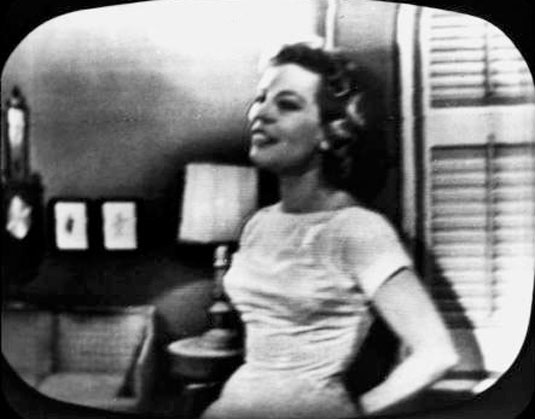
Video recording image from 1955 shows continued improvements
Yet what really saved the day was a brand-new batch of sample tape that performed better than anything they’d received before. It made all the difference and the Mark IV managed to achieve the performance expectations to satisfy all and sundry and certainly exceeded what the Ampex team had witnessed up until then.
Bing's search results
Keen to repeat his success with Ampex audio recorders, Jack Mullin asked distinguished engineer Wayne R Johnson to join him to explore the possibilities of developing a video recorder. They succeeded in getting funding for a video venture from Bing Crosby and Bing Crosby Enterprises (BCE) was formed to commence work on this project.
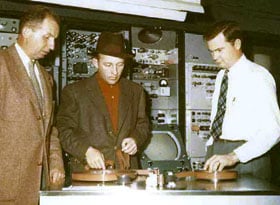
BCE video days: Jack Mullin, Bing Crosby and Wayne Johnson
Source: IEEE GHN
By 11 November 1951, the team gave an early demo of its progress using 1/4in tape running at 360IPS with 12 tape heads – 10 for video, one for sync and one for audio. With bandwidth tailing off at 1MHz, the dark snowy footage of an aeroplane taking off was only saved from obscurity for viewers by a commentary during the demo describing the action.
Two more BCE models were made, with the MkII tape size increasing to 1-inch. The MkIII featured input from General Electric which involved reducing the tape size to 1/2-inch, dropping the track count to 10 and lowering the speed to 100IPS for 16 minutes recording. Even with later tweaks, it wasn’t suitable for broadcast. The image quality being no match for the kinescope, appearing grainy, and like a worn film.
For video, BCE’s achievements amounted to demonstrating the first recorder, yet the difficulties of longitudinal video recording remained insurmountable. The full story from one of those involved in the project is here.
Reel-time playback
At the NARTB show, the Ampex Mark IV video recorder was hailed as a game changer and everybody in TV wanted one. On 30 November 1956 it made history when a video recording was used on-air for the first time from CBS Television City, Hollywood to rebroadcast Douglas Edwards with the News to West Coast audiences hours after the original live broadcast from New York City.
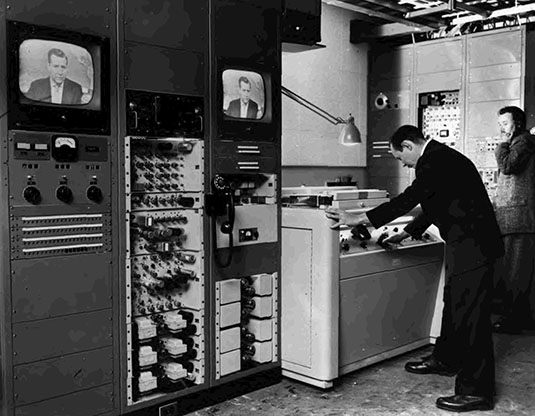
The Doug Edwards show relayed on an Ampex recorder
The production video machines became known Quadruplex or just Quad tape recorders, describing the four-head array on the drum and the remodelled Mark IV was marketed as the VR-1000, although 16 hand-built early models were known as the VRX-1000. RCA gave Ampex a helping hand to produce colour models following the VR-1000, and that good turn was rewarded with Ampex enabling RCA to make its recorders Quad tape compatible.
The Ampex VR-1000 cost $45,000 and the 2-inch tapes, which now ran at 15IPS (and later 7.5IPS) enabled an hour of recording and cost $300 apiece. The company coined the phrase “Video Tape” and RCA chose “Television Tape” but it was the term videotape that stuck.
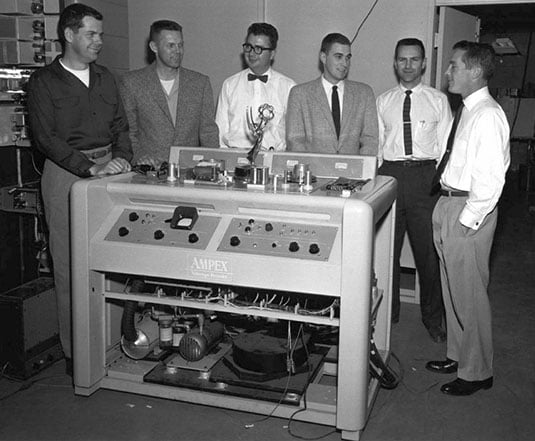
Emmy Technical Achievement Award winners for the Ampex team with VR1000 video recorder
Left to right: Charles Anderson, Shelby Henderson, Alex Maxey, Ray Dolby, Fred Pfost and Charles Ginsburg
Engineering talent aside, Ampex would soon have another card in its favour as its VR-1000 machines went into production.
In 1956, Ampex set about investing in US tape manufacturer ORRadio (see box section below), putting in a 25 per cent stake with a view to buying the company if all went well. Indeed, Ampex did take ownership of ORRadio in 1959 after first enforcing more robust management under John Leslie. Under the Ampex Magnetic Tape Company banner, the Opelika facility remained focused on consumer tape production, while a second plant was set up at the firm’s base in Redwood City, California dedicated to manufacturing professional media.
As Ampex continued to make advances in audio and video, its capacity to refine the essential magnetic media that made it all possible would support its tape-based products for the next 36 years. In 1995 Ampex spun off its recording media division, which became known as Quantegy. A decade later, Quantegy closed the doors to its Opelika manufacturing plant and filed for bankruptcy, a casualty of the rise in disk-based desktop audio and video systems.
Attempts to the revive the company under new ownership were fêted and in 2007 equipment was dismantled or sold as part of the bankruptcy clearance. This has slowed progress for yet another revival but @Quantegyonline Twitter feed suggests GP9 1/2-inch and 2-inch tape is once again in production in small numbers.
Transistor switch
The notion of video recording on magnetic tape hadn’t escaped notice of Japan either. The country was now entering a post-war “Miracle Growth” period that allowed access to US technology as part of a security settlement. While America remained keen to protect its investment in valve (vacuum tube) tech and was slow to change, the Japanese were on a roll with transistor production.
These developments would eventually help the shrinking of the VTR from something like a commercial deep freezer to a more family friendly suitcase size, but there was still some way to go.
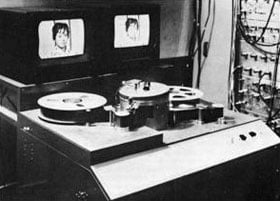
Toshiba's VTR-1 helical scan recorder: note the reel heights
Since 1954, Toshiba had been working on its rotary head video recorder. Its VTR-0 prototype from 1956 used 2-inch tape at 15IPS, and utilised a single head.
Significantly, it was a helical scan design – a diagonal tracking approach which is explained in part two – with an almost complete tape wrap around the head, which being 2-inch wide wasn’t ideal. It also meant that one reel was mounted higher than the other so the tape could twist around the head.
In September 1959, the company announced its experimental VTR-1, which worked out at around 1/10th price of the quad-head Ampex model. Yet given compatibility issues with the already established Quadruplex system, it failed to gain traction in broadcast facilities and Toshiba began working with Ampex in 1964 to produce machines to the American manufacturer’s spec. The staggered reel, helical scan design appears to have made it to VR-1500, Ampex’s “domestic” video recorder.
However, Toshiba did go on to make even cheaper versions of its own design for industrial use. Its helical scan approach soon formed the basis of domestic video recorders that would follow. Rather inconveniently, the Toshiba Museum is closed until 2014, however, the wonderfully absorbing LabGuy's World provides an overview of the tech with some images including the colour model from 1962 and Toshiba’s fixed head design system from 1979.
Sony, whose interest had been piqued by Toshiba’s earlier efforts, had already established a relationship with Ampex by 1960. In exchange for Sony’s transistor knowhow, Ampex shared its VTR patents with the Japanese firm. Sony’s SV-201 was a two-head helical scan model running at 7IPS. Albeit the world’s first transistorised VTR, but the format didn’t appeal to broadcast and was too big for home use.
Extraordinary renditions
Jack Mullin wasn’t the only American to wander back from Germany with an AEG recorder and a stack of tapes after WWII. John Herbert Orr’s story is a somewhat darker tale as he was in the US Army Psychological Warfare Division and his job was to not only grab this equipment, but the German forces personnel operating it.
A likely story that gets repeated everywhere, and is too good to miss here, is that American president Dwight D Eisenhower decided he should record a message to be played to the German people. The Psychological Warfare Division was actively broadcasting propaganda from within Germany using captured facilities and Dwight’s message was going to be the icing on the cake.
However, El Presidente’s voice was recorded on a re-used reel of tape from Germany – they hadn’t erased the previous recording properly. Apparently, the result was a duet with Hitler, who was also audible in places. As far as psychological warfare goes, that broadcast probably did a pretty good job of disorientating the German listeners. The incident led to Eisenhower banning the re-use of German tape and ordering Major Orr to set about producing fresh tape in the US using captured German scientists to put together a manufacturing plant.
Online tales abound that Orr had contacted Dr Karl Pfleumer, whoever he was. Fritz Pfleumer was the big name behind magnetic tape who died in 1945 and whose work is explored extensively in part one. Decades later, one newspaper, reports fancifully that when Major Orr was injured in a car accident, Dr “Karl” regularly visited him in hospital and handed him an envelope containing the formula for magnetic tape and its production. Back in action, it's claimed Major Orr even managed to knock out samples in two weeks from Germany.
Following the war, John Orr put what he’d learned from the German scientists to work and set up his own business manufacturing magnetic tape in Opelika, Alabama. As one of only four US concerns producing tape, ORRadio Industries – along with 3M, Audio Devices and Reeves Soundcraft – were asked by John Leslie to send samples to Ampex for evaluation. One of Leslie’s first tasks at Ampex was to build an 8-track audio recorder, ably assisted by Ray Dolby, then only 17.
Leslie was keen to identify a supplier able to deliver consistent tape quality and told the four companies that he would share his findings with them. As it turned out, it was ORRadio’s Irish Brand tape that performed the best. ORRadio had developed a post-coating process called FerroSheen which was intended to deliver improved tape-to-head contact. It seems ORRadio had something there, as its Irish brand delivered the most consistent output during repeated record/playback comparative tests.
Format formation
In September 1962, Sony evidently overstepped the mark when it showed off the world’s first “compact” transistorised “Videocorder” the PV-100. This was snapped up by American Airlines in 1964 as an in-flight VTR and PanAm would follow a year later.
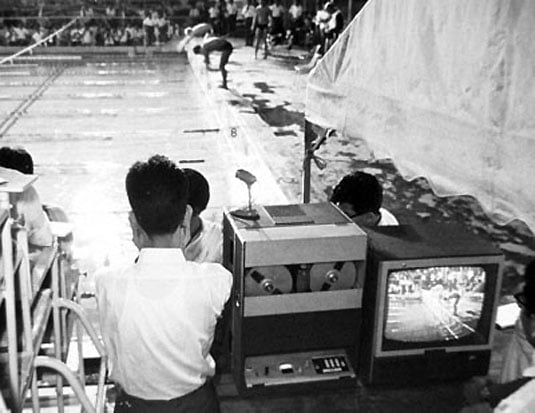
Sony PV-100 Videocorder at an outside broadcast swimming event
Ampex was not best pleased and sued Sony over this product in 1966. This open reel player was certainly a step up from film projection, but the flight attendants frequently messed up the tape threading and the tapes too, due to careless handling among the in-flight catering.
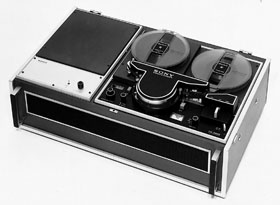
Sony CV-2000 reel-to-reel consumer video recorder
Undaunted, Sony marketed its own helical scan VTR in 1963. The CV-2000 used open reels and 1/2-inch tape and cost just under $1,000.
It wasn’t just Sony and Toshiba getting busy with video, they were all it.
JVC came up with quite a few innovations, including the KV-1, the world’s first two-head helical scan VTR in 1959, with a colour version appearing the following year.
By 1963 it had developed the smallest two-head 1-inch VTR with a built in monitor and put together a cartridge format that was the forerunner of the U-Matic video cassette.
The company’s research into colour video led to the widespread adoption of its recording method which separates the colour (chroma – hue and saturation) and luminance (brightness) characteristics of the composite video signal.
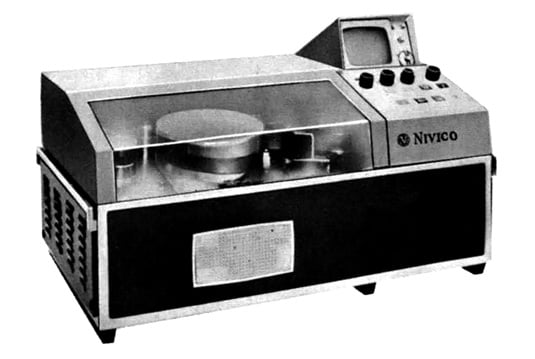
JVC Nivico KV-2 helical scan video recorder from 1964
Described as “colour under”, this "down-converting" the colour signal to a lower frequency on record and re-converting it on playback became a standard process on U-Matic, 8mm video, Hi-8, VHS and S-VHS video recorders.
Shall we do the Betamax v VHS wars now or save it for later? OK, we’ll cover it shortly.
U-Matic universe
Although Sony would be the first to show off a U-Matic prototype in 1969, the format was developed in co-operation with JVC, Matsushita (Panasonic) and a handful of manufacturers outside of Japan. It used 3/4-inch tape and although Sony had hopes for it to become a consumer format, both tapes and recorder were costly and so it had more success with business and institutions.
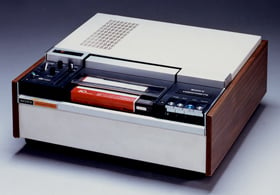
Sony VP-1100 U-matic video recorder
The introduction of Sony’s portable VO-3800 system in 1974 saw U-Matic systems take off with broadcasters who were keen to utilise its instant playback in the field. Previously, film cameras were used which involved the delay of film processing.
The VO-3800 had its quirks though, while it could record in colour, the playback would be monochrome unless an the mains adapter/charger with the colour circuitry on-board was to hand. The idea was to save weight and this arrangement brought the recorder pack down to a mere 30lbs.
U-matic hadn't completely won over the broadcast industry though as the Type C, 1-inch open-reel recorder – another Ampex-Sony collaboration from 1976 – would dominate analogue television production for 20 years because of its high quality output and reliability.
So was Europe asleep during all this time? Had the video effort run out of steam once Auntie’s VERA had spun its last? As far as Philips was concerned, the show had just begun. It had been manufacturing open-reel, rotary head recorders since the mid-1960s which, like its audio equipment, were marketed under the Norelco brand name in the USA. If you speak Dutch, you'll find Marcel's TV Museum, that features vintage video gear that was circulating in Europe, to be well worth a peruse.
Arguably, Philips pioneered the domestic video recorder with the N1500 appearing in 1972. The machine was a cassette-based system where the two spools sat on top of each other providing a slanted tape feed that was ideal for the helical scan recording. These unique square cassettes containing 1/2-inch tape running at 11.26IPS originally had a maximum recording time of only 45 minutes but this was later extended to an hour.
Indeed, it was the recording capacity of the early consumer systems that played a major role in their fate, that and the cost of the video cassette tapes.
Philips’ VCR format certainly wasn’t cheap costing the equivalent of £1.50 a minute in today’s money and the format wasn’t too reliable either, which when you’re spending close to 100 quid for a tape, is going to sting a bit when it gets chewed. Both Grundig and Loewe had a stab at this format too.
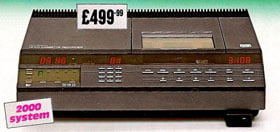
Pye 2023 Video 2000 video recorder from 1983
Despite the Betamax v VHS war hotting up in Asia and the US, Philips developed a second format that appeared in 1978. The Video Compact Cassette (VCC) that was used in the company’s Video 2000 (V2000) machines had the unique distinction of being two-sided.
You could flip the tape over like an audio cassette and get double the recording time. Initially, the duration was a maximum of 4 hours per side on 1/2-inch tape, amounting to a 1/4-inch video track per side running at 2.44cm/s. The recording capacity would later increase to eight hours per side on some models.
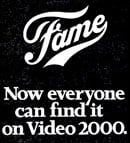
So there you have a neat format with bags of recording time and yet it still didn’t catch on! In many respects it was technically superior to its Betamax and VHS rivals which had appeared before it, and Philips believed the picture quality to be far better too.
The problem this time was the video library rental market and V2000 just didn’t make an impression, with VHS becoming the most widely supported. Another factor being the equipment rental which was still a feature in UK High Streets until around 2000.
Philips V2000 promo video: the tech fun starts at 1' 05"
Expensive TV and video gear could be leased this way for a monthly fee and many companies had affiliations with brands supporting VHS. And as VHS became more widespread, the tapes became cheaper too.
Random elements
Over time, rotary head designs proved themselves to work reliably with magnetic tape, but they did require additional considerations for media manufacture. According to Ampex’s Fred Pfost, who was behind those early quadruplex designs, during tests they had noticed playback variations in amplitude and began to wonder if it had anything to do with the 3M 2in tape that was being used.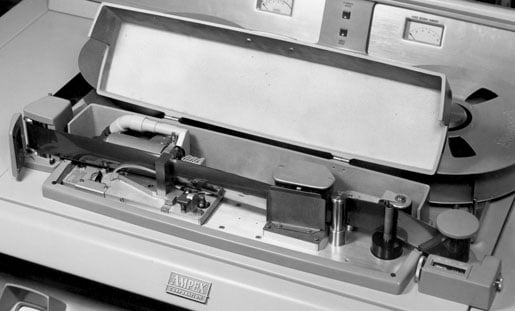
Ampex Quadruplex head tape path
Pondering on this, they finally realised that, as they were using audio tape, it would have gone through a particle alignment process – a magnetisation that occurs once the tape has been coating that is described in part one.
Lining up the needle-like particles suits longitudinal audio recording, but not the transverse rotary head recording the Ampex video recorders were performing. To deal with this issue, Ampex requested 3M ceased providing tape with pre-aligned particles.
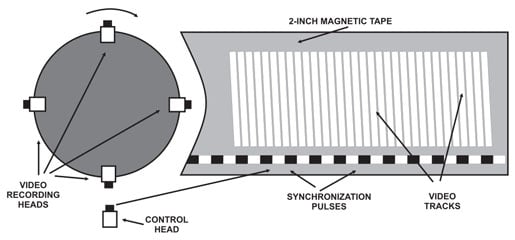
Ampex Quadruplex head tracks on tape. Source: Wikimedia
It wanted the tape supplied without this orientation process, so a random formulation would result and consequently an improved response from the rotary head. While this did help, at that time Ampex had further work to do on the head orientation and the tape path to attain the image stability it was seeking.
How to make friends and influence people
When it comes to formats, Sony has quite a respectable track record – the company even set up its own tape-manufacturing plant in 1950 to support whatever it came up with. There will always be winners and losers though. Remember the Elcaset? No? Me neither. More here, if you’re keen.
To digress for a moment, the Elcaset was Sony’s mega cassette hi-fi format from 1976. Legend has it that the company had so many unsold Elcasets that it hired a container ship, loaded it up with this ill-fated format and then dumped the lot in the sea. Having your own tape plant can have disadvantages if over-optimistic forecasts for supply fail to match demand.
John Cleese does a turn for those "Awfully nice Sony people". The SL-C7 Betamax kit here dates back to 1979
Sony’s Betamax failed in the consumer market for a couple of reasons. The first was its one-hour recording time – the capacity challenge was always going to bite videocassette format pioneers – and the second had political overtones of more than one hue.
The story goes that seven months ahead of the launch of Betamax, the Sony chairman Akio Morita showed off the company’s new consumer video recorder to the top brass from JVC, RCA and Matsushita (Panasonic). It was presented as a fait accompli which ruffled a few feathers.
Beta blockers
Rather than joining Sony to promote the Betamax consumer video format, the execs felt sidelined and went about producing a rival system. Sony had shot itself in the foot with this technology briefing, as it had involved these potential partners too late and had also given away some of its ideas in the process.
Apparently, the Japanese Ministry of International Trade and Industry (MITI) had a hand in things too in a bid to standardise a video format back in 1974. Sony’s work on the unreleased Betamax format was enough to convince MITI that it should become the standard, and could be made under license by other manufacturers.
JVC had been busy developing the Video Home System (VHS) and played Matsushita off against Sony in order to get the company to adopt VHS.
JVC was touting VHS as an open standard and once Matsushita was in, others such as Hitachi, Mitsubishi and Sharp followed.
Consequently, MITI was forced to withdraw its initiative for an industry standard consumer video cassette, and the format war began in earnest.
Shall we talk about porn? While there’s no hard evidence per se, there are plenty of references to Betamax not succeeding due to a lack of bare flesh on the format. The recording length is quoted as a reason by some, the cheaper VHS tapes by others and there are even stories that Sony was anti-porn.
Yet the idea that Sony could effectively veto the use of its recorders for porn reproduction seems questionable. Porn certainly pumped the growth of the internet, so it seems as good a reason as any that its appearance on one format over another would give the adult entertainer an easy ride.
Sony didn’t give up on Betamax though as it migrated to become its professional recording format and was even used on its Digital Betacams – the physical cassette remained the same, only the tape formulation was different and, of course, the head array.
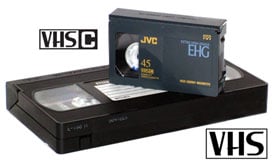
Adapter enclosures for VHS-C tapes existed to convert
them into full-size VHS for playback on home systems
In the 1980s compact consumer formats were born with JVC’s VHS-C arriving in 1982 and Sony’s Video8 appearing in 1985 with a smaller cassette size. Like Betamax, the Video8 format would later go digital but featuring backwards compatibility.
As Philips had done with DCC by supporting analogue audio cassettes, Digital8 equipment could play analogue Video8 cassettes. What I found even more impressive when I borrowed one was that the analogue Video8 content would be digitised and sent out of the iLink (FireWire) port, which I put to good use making digital transfers to a MiniDV recorder, the latter becoming the most popular digital videotape for consumer and semi-professional use.
Tape baking recipes
Traditionally, magnetic tape has comprised several layers: the actual film (substrate), the magnetic coating (pigment) and in most cases a back coat. As described in part one, Pfleumer devised a caramel-like suspension of magnetic particles that would bind the pigment to the tape. For conventional formulations, this method has endured – albeit refined and further enhanced by the addition of lubricants within the binder/particle suspension.As tape ages, these various ingredients degrade in different ways. Sometimes playing an old tape will shed the metal oxide particles onto the head and transport components. Other scenarios include the tape’s oxide coating sticking to the back of the layer as it wraps around on the spool, so that it becomes stripped when the tape is unwound.
Since the 1960s, the actual tape substrate has gravitated to a polyester base which has proved to be a good deal more stable over time than the pigment binders, which are the real problem here. The binding agent pretty much determines the shelf life of magnetic tape.
Binders can deteriorate in a number of ways, one of the most common problem being caused by the absorption of water over time. This is the cause of sticky-tape symptoms that shed the magnetic coating and clogs video heads (sticky shed). The tape will also cling to audio heads (stick slip), that can result in a screeching noise from the media as a consequence.
If old tape exhibits these characteristics it can be made playable by baking it. In 1993, Ampex even patented the method, which isn’t as hot as it sounds. A domestic oven would produce a disastrous meltdown, as we’re talking about warming the tape over time to drive out the moisture. Ampex suggests a temperature of 54˚C (130˚F) for up to 16 hours.
Those in the know vary the times and temperatures according to tape width, so may 1/2-inch tape could be ready in as little as two hours with a 2-inch tape taking anything between four and eight hours.
Professional drying cabinets exist for this purpose and if you are inclined to experiment, just be sure you’re not using a Fahrenheit figure on a centigrade heater. There's even an alternative hairdryer method.
Acetate-based tape has its own problems which can lead to vinegar syndrome which is a cause of rapid deterioration. It is a problem that affects old cine films too, and methods to deal with it are similar for magnetic tape and are described in detail here [PDF].
One other problem is the loss of tape lubricant and this can be restored by relubrication, which is bit more involved than it sounds. If you add too much lubricant it can obstruct head-to-tape contact and the playback signal will suffer as a result. A summary of the various issues is highlighted here.
Just getting tape off a reel is a science in itself and and all this before you even get to any alignment or format issues. As for wow and flutter, Celemony has developed the amazing Capstan signal processing software to deal with that.
Hi standards
As with digital audio, the arrival of digital video did involve repurposing existing analogue transports and tape formats. Early digital audio stereo mastering would rely on adapted video recorders, the details of which are explained in an earlier El Reg article How digital Audio Ate Itself and the Music Industry (part one).
Likewise, these digitised video formats would also find applications in data storage, which is what these systems had effectively become. A Video8 spin-off known as Data8 was adopted by Exabyte. The use of tape for data storage and its related technical challenges in digital audio recording systems is explored extensively in part two.
Indeed, the improved formulation of Hi8 tapes – originally intended for the higher resolution Video8 replacement – would also be used on Tascam’s DTRS format 8-track digital audio recorders. Similarly, S-VHS offered improved resolution and its tape cassettes would also find its way into the Alesis A-DAT 8-track digital audio recorders, a popular modular system from the 1990s. S-VHS, rebadged as Digital-S would also be used for JVC’s D-9 digital video system.
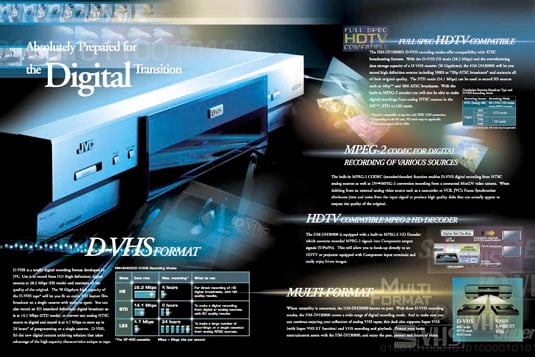
JVC HM-DH30000 D-VHS recorder: HD TV and D-Theatre too, how can you resist?
JVC even tried out D-VHS as a way of offering backward-compatibility with analogue tapes. There were D-Theatre pre-recorded D-VHS tapes too with 5.1 Dolby Digital sound and 1080p video resolution. FireWire (iLink) was onboard too, enabling digital transfers. Check out what you were missing in this brochure from 2002 [PDF].
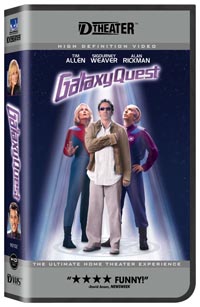
D-VHS movie with D-Theatre
By the mid-1990s, portable digital video formats were in abundance for both professional and consumer use. The DV standard emerged, supported by over 60 companies including Sony. However there were different approaches to data rates and codecs (yet with some interchangeability).
In short, there were two main variants: Sony pushed DVCAM and Panasonic offered DVCPRO. Film and video veteran Adam Wilt provides an overview of the DV format variants here and a somewhat US-centric technical comparison of analogue and digital formats is here. An exhaustive list of analogue and digital videotape formats is here.
Professional broadcast digital video systems would centre on the uncompressed D-1, D-2 and D-3 tape formats. D-1 is often referred to as Rec 601 – ITU Recommendation 601, an international technical standard for standard definition television. Nowadays, Rec 709 refers to HDTV and Rec 2020 to Ultra HD TV. A range of broadcast-related ITU recommendations can be found here.
Costly component
D-1 was introduced by Sony in 1986 and cost a fortune as the colour was stored in component format, which has three separate signals YCBCR where is Y (luminance), CB (Chroma Blue) and CR (Chroma Red) and together they represent the video colour space. It’s a bit more involved than just RGB and in those early days it was handled on equipment prior to the arrival of cheaper and commonplace digital vision mixing desks.
The video cassette used 3/4-inch tape with a maximum recording time of 94 minutes and recording clocked up an amazing 173Mbit/sec data rate.
Ampex saw an opportunity here for a lower cost composite system and worked with Sony and in 1998 announced the D2 3/4-inch format. Not to be outdone, Panasonic introduced its D3 composite rival on 1/2-inch tape in 1991 and in 1994 the company managed its own component system, D5.
Ampex D-2 format promotional video
Incidentally, D-7 was a compressed component format from Panasonic’s DVCPRO stable and was on 1/4-inch tape. D4 never appeared due to Asian traditions concerning the number four, which when spoken in Chinese sounds similar to the word for death.
The use of tape with helical scan heads again proved itself as a reliable means to store substantial amounts of for television broadcast purposes, but digitally this time. Despite a range of different options for studio and outside broadcast, there was, fortunately, some compatibility between competing digital video cassette systems. However, there was one limiting factor: the tape formulation.
Metal particle (MP) tape was pretty much a refinement of the old science dating back to Pfleumer’s days. Nothing wrong with that, as it has a proven track record – literally. Over the years, tape tech introduced the use of lubricants that are part of the magnetic particle layer that is technically referred to as the pigment.
Much like squeezing a sponge, the pigment releases the lubricating component of its formulation under exertion when travelling over the head and other transport components. When those contact forces subside the lubricant is reabsorbed again, just like releasing a sponge.
Metal Evaporate (ME) tape, also has its lubrication layer, which is added after the tape has had its coating. The tape production processes involved for ME are quite different. Metal vapour clings to the tape base without the need for adhesive binders and a protective coating and lubricant is added later. While the behaviour of the lubricant in the machine is much the same, the tape tension required to get the same effect is lower with ME tapes and needs to be taken into account.
Dirty videos
Video cameras were often able to accommodate both formulations – the cassettes would have indentations positioned to identify the tape type and could alter response characteristics, much like switching from a chromium dioxide cassette to a metal one on an audio system. However, there were frequent user reports that tape heads were becoming clogged as a consequence of tape interchange with ME and MP formulations, but this was more likely to do with tension issues.
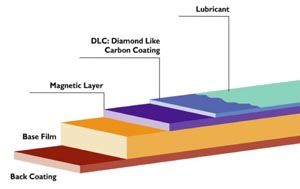
Sony ME tape layers: this method doesn't need binding agents
The arguments even led Sony to present a white paper into the issue of clogged heads. The full report, The Truth About Tape Lubricant can be found here [PDF]. From this, it seems Sony was not convinced of the clogged heads theories that had circulated for years, describing it as “hearsay” and “misleading to end users” adding that the DVC tape specification should not cause problems.
However, Sony acknowledged that in years gone by there were numerous ME tape makers and hence a wider variety of lubricants used which may have been a factor. The paper from 2009 goes on to say, “Today there are half as many manufacturers producing metal evaporated tape, hence, the number of different lubricants in use has dropped considerably.”
There are even fewer manufacturers of magnetic tape now and for video, most formats have given way to solid state and hard disk recording alternatives. Still, this does lead to a very real issue regarding tape and one that is worth winding up this subject on.
Magnetic moments
No doubt we’ve produced enough magnetic tape to wrap around the rings of Saturn a few times and a lot of what has been recorded contains some pretty unique stuff. Indeed, record companies and broadcasters consider trawling their archives as both a moneyspinner and cheap entertainment:
Look what we’ve found, another Beatles demo – kerching. What have we here under this disused Police box? It looks like 100 early episodes of Dr Who and you’d thought they’d been exterminated.
Stuff just keeps turning up and yet no matter what it says on the label, the real value lies in whether it can actually be replayed. With some aforethought, a lot of it can be restored and transferred to yet another medium with its own shelf-life issues.
As recording media goes, tape’s linear playback qualities may seem idiosyncratic these days, but it really does stand the test of time. Yet to say that there is a tape revival would be far from the truth.
However, the revival of magnetic tape from bygone eras dating back over 80 years is an ongoing process that enriches our knowledge, our culture and, indubitably, our entertainment. ®
